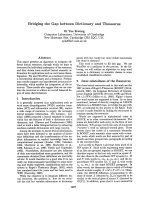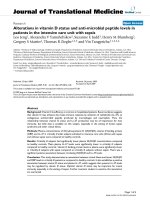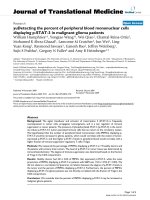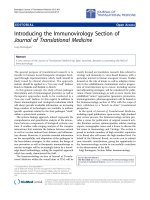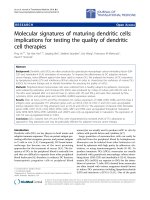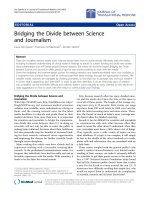Báo cáo hóa học: " Editorial The Interplay between Compression and Security for Image and Video Communication and Adaptation over Networks" potx
Bạn đang xem bản rút gọn của tài liệu. Xem và tải ngay bản đầy đủ của tài liệu tại đây (419.72 KB, 2 trang )
Hindawi Publishing Corporation
EURASIP Journal on Information Security
Volume 2007, Article ID 19824, 2 pages
doi:10.1155/2007/19824
Editorial
The Interplay between Compression and Security for Image
and Video Communication and Adaptation over Networks
Enrico Magli
1
and Qibin Sun
2
1
Dipartimento di Elettronica, Politecnico di Torino, Corso Duca degli Abruzzi 24, Torino 10129, Italy
2
Institute for Infocomm Research, 21 Heng Mui Keng Terrace, Singapore 119613
Correspondence should be addressed to Enrico Magli,
Received 6 December 2007; Accepted 6 December 2007
Copyright © 2007 E. Magli and Q. Sun. This is an open access article distributed under the Creative Commons Attribution
License, which permits unrestricted use, distribution, and reproduction in any medium, provided the original work is properly
cited.
We are witnessing an unprecedented diffusion of multime-
dia contents over heterogeneous networks, to desktop and
mobile users, with different access bandwidth and quality-
of-service requirements and capabilities. Compression is one
of the technologies that are making it all possible, by allowing
data rate reduction, transcoding, and rate adaptation, which
are crucial in the scenario of time-varying communication
channels. At the same time, digital rights management is be-
coming an increasingly important field because of the con-
tents owners’ need to protect the data from unauthorized use
and verify their origin; hence comes the need to add security
features to compressed multimedia contents.
However, the joint provision of compression and secu-
rity capabilities is not devoid of problems. Although encryp-
tion offers a high level of security, it can hinder compression,
for example, by altering the statistics of the coefficients to
be coded, or the syntax of the compressed file, potentially
resulting into a compression loss, or rendering compressed-
domain processing difficult or impossible. Other techniques
such as data scrambling are more flexible, but also potentially
less secure. Recently, there has been a significant amount of
research work aimed at finding new ways to integrate data
protection techniques into existing and new compression
systems, in order to achieve joint compression and security.
This integration allows exploiting the hierarchical signal rep-
resentation in a transform domain, as used by most image
and video compression techniques, in order to provide the
advanced functionalities required by many modern applica-
tions. The forthcoming release of the ISO/IEC JPEG 2000
Part 9 (JPSEC) standard, whose development has witnessed a
significant interest from the industry and academia, is an ex-
ample of how compression and securit y can coexist and take
advantage of each other.
The six selected pap ers in this special issue provide an
up-to-date picture of state-of-the-art research in the field
of compression and security, emphasizing the interplay be-
tween these two aspec ts.
The first two papers address the provision of security fea-
tures within the JPEG 2000 image compression framework.
Engel et al. in their paper “Format-compliant JPEG2000 en-
cryption in JPSEC: security, applicability, and the impact of
compression parameters” consider the new JPSEC standard
for secure image communication. They present a packet body
encryption scheme that maintains compliance with the syn-
tax, as well as a scheme that encrypts the packet headers in
order to improve security. Moreover, they analyze the impact
of several parameters on the security and compression per-
formance.
The second paper, by Yang et al., also proposes an en-
cryption algorithm for JPEG 2000. In their manuscript “Ef-
ficient and syntax-compliant JPEG 2000 encryption preserv-
ing original fine gr anularity of scalability,” the authors de-
scribe a new syntax-preserving encry ption primitive, and its
application to JPEG 2000. The objective is to allow manipu-
lation of the compressed file by, for example, truncating the
codestream for transcoding, without compromising security.
The next two papers deal with encryption for video com-
pression. In their paper “Digital video encryption algor ithms
based on correlation-preserving permutations,” Socek et al.
propose an encryption algorithm that preserves the spatial
correlation. In this way, encryption can be performed before
compression without disrupting the coding efficiency. This
allows to achieve many useful functionalities, such as format-
compliance, quality and rate control, and low complexity.
The fourth paper, “Joint encryption and compression
with side information of correlated sources,” addresses the
2 EURASIP Journal on Information Security
problem of security in a distributed video coding frame-
work, where the correlation of adjacent frames is exploited
at the decoder, as opposed to the encoder. In their algorithm,
Haleem et al. use a structure similar to AES, in which the
Slepian-Wolf coder takes the twofold role of compression
step and diffusion step for security.
The last two papers are in the field of secure entropy cod-
ing, and address the design of entropy coders that can achieve
both compression and encryption. In their paper “Multime-
dia encryption with joint randomized entropy coding and
rotation in partitioned bitstream,” Xie and Kuo propose a
framework that couples randomized entropy coding and bit-
stream rotation in order to improve the security. They show
that their scheme makes known and chosen plaintext attacks
extremely difficult.
The last paper by Magli et al., “Joint source, channel cod-
ing, and secrecy,” deals with the problem where compressed
and secured data have to be transmitted over a noisy channel.
It is shown that compression, security, and error protection
can be implemented into a single tool. They proposed and
compare two such schemes, based on arithmetic coding and
turbo coding, respectively.
We present this special issue believing that the interplay
between compression and encryption is an important re-
search topic, which is highly actual, and will open the way
to more research work in the future. We tried our best to em-
brace the many new research points in this area and com-
bine them into this special issue. Our special thanks go to the
reviewers who helped select and shape the papers presented
here. We hope these papers will provide a helpful and stimu-
lating reading.
Enrico Magli
Qibin Sun
